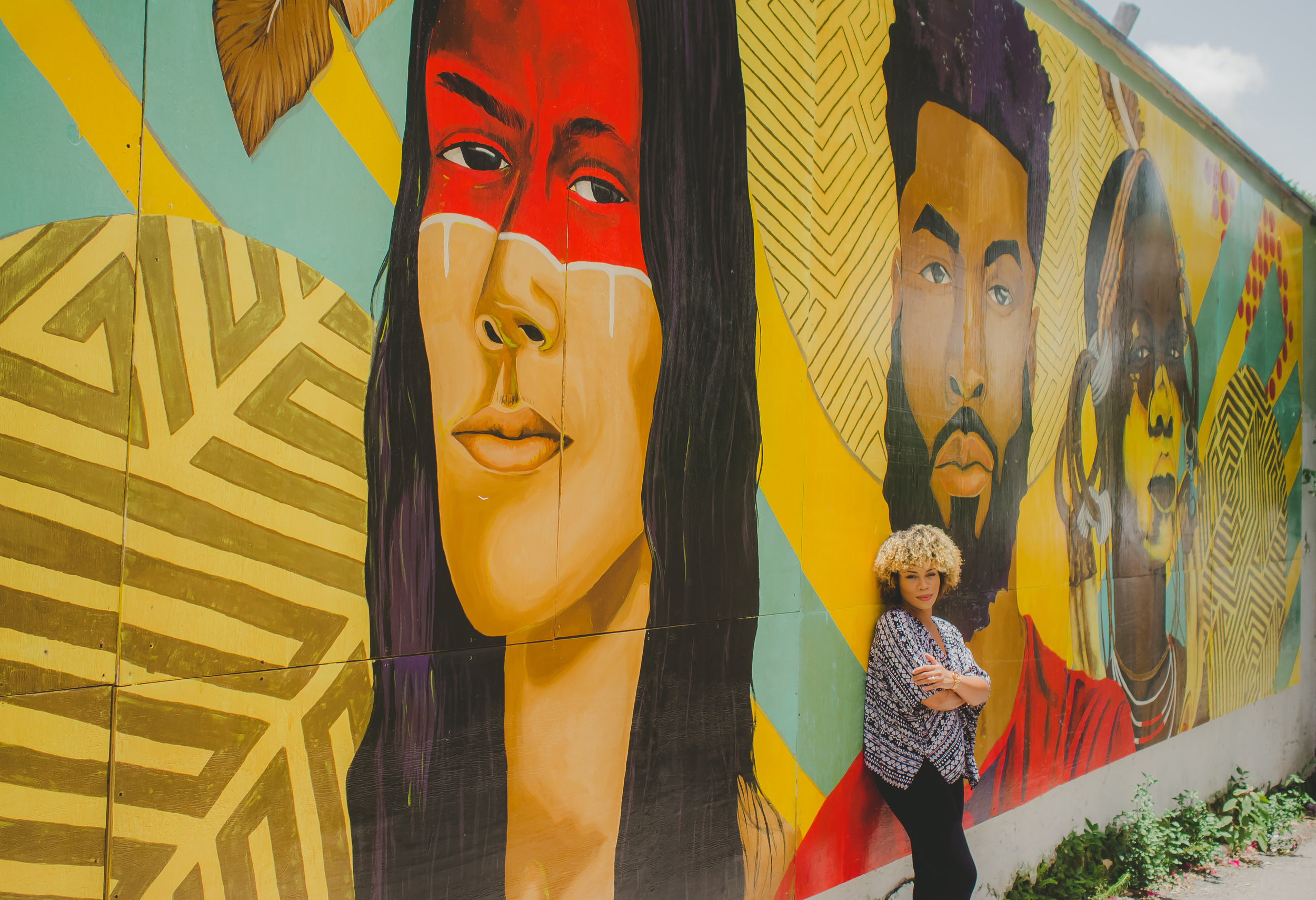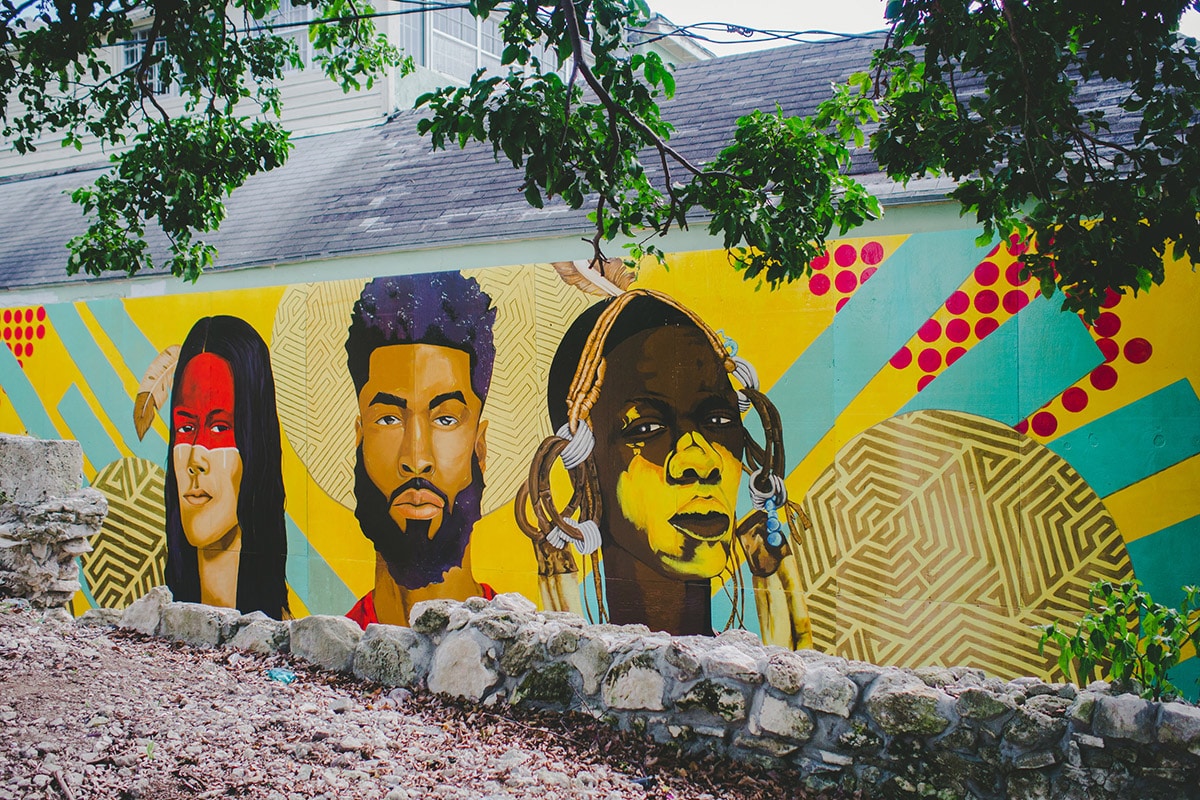
By Natalie Willis
The history of healing in The Bahamas – indigenous medicine, African botanical wisdom, and hospitals – is a shifting and complex one. In her new public artwork for Hospital Lane – historically significant but also struggling from a particular kind of contemporary notoriety – Darchell Henderson gives us a brief look into some of the anthropology of this particular archipelago. The painted mural, entitled “Legacy” (2018), by a mere show of 3 faces gives excellent insight into some of the lineages of the majority population of this space: an imagined Arawak, modelled off of their First Nations cousins, a regal African tribesman, and a modern-day Black Bahamian. Our mixing of colonial heritage, first with the Spanish who decimated much of the Arawak, Lucayan and Taino population, and later the British who filled that vacuum with enslaved Africans and White British settlers,, combine with a melange of other migrated and nomadic peoples trickling in throughout the centuries, such as the Seminoles, who settled in Abaco along with freed African-Amercans in the 1820s, or historcal Chinese and Greek populations. All of this has impacted how the majority of Bahamians look, live and feel as we all deal with the weight of history in our landscape.

“Legacy” (2018) public mural by Darchell Henderson on Hospital Lane in Nassau, New Providence.
Taking first the young man on the left of the massive wall painting, with the red-painted, flat forehead, we imagine The Bahamas in its inception of human activity, shifting from first and foremost being an indigenous space into our initial wave of Spanish colonial activity that grounded much of the written and historical views of the island in terms of health and wellness. Europe was fascinated with the West Indies after our Western “discovery”, but they were also ultimately terrified of this unknown land with its strange ailments – a parallel that was solidified by the British here later. Nomadic travelers like the Lucayans viewed the space as one of opportunity, but Spanish colonial settlers viewed us as a space of simultaneous opportunity and strange disease, with a sad irony sincethe Arawaks and Lucayans were close to eradicated not only through the horrific violence of the Spanish, but also the sexually transmitted infections brought from Europe, with which indigenous peoples’ genetics simply could not cope. There was of course not a single hospital, as we currently know them, but there would undoubtedly have been someone charged with medicine and healing in either camp.
Shifting to the adorned and regal tribesman on the far right, we enter the second wave of colonial activity with Britain and the story of how Hospital Lane got its name. The first true hospital would come in the late 1700s, around 1780 though the dates are not exact, and it was referred to as The African Hospital. For those scratching their heads, the construction of the hospital did not signal the first arrival of medicine to the islands, there were families with private physicians, but the general populace was largely left to fend for themselves. The African Hospital was built primarily for the treatment of enslaved Africans, from whom our Bahamian majority are descended. This was also a matter of protecting the investment of human labour more than humanitarian effort, but it is interesting to think that this space might have provided a merging point between traditional West African medicine and the European medicine of the time – a painful but poignant reminder of how this history lives on. In 1789, Chief Justice Stephen Delancey acquired 150 acres of land “behind the hospital” to form Delancey Town, and it was he who had arranged for the limestone ridge on West Hill Street to be carved out to form Hospital Lane.

“Legacy” (2018) public mural by Darchell Henderson on Hospital Lane in Nassau, New Providence.
The remains of this site have recently been preserved and renovated as part of the campus at the NAGB. The transformation of this historic lot into a sculpture garden and amphitheatre required the movement of centuries of the sedimentation of Bahamian life – earth, pottery shards, and all manner of everyday detritus from yesteryear gave way to the current site. The idea of healing is integral to the development of this space as it is now. Weeds are replaced by all indigenous species of plants, primarily pre-Columbian where possible, and the amphitheatre, Fiona’s Theatre—where some remains of what could be part of the African Hospital have been restore—is made possible through the healing of a family remembering a daughter taken too early. The National Art Gallery itself, in the former Villa Doyle, is a reclamation of a space built by Black Bahamian ancestors. Healing takes remembering as much as it does re-writing and re-thinking spaces.

Darchell Henderson, the artist for “Legacy” (2018) on Hospital Lane.
This brings us to our third portrait on the mural. The young man looks like many modern-day Bahamians, but also contemporary African Americans, Jamaicans, Haitians, Bajans, Trinidadians. We in the Caribbean are this merging point of the world, and it shows in those who make up our population. Bahamians of African descent, Greek, Chinese, American, European, and all those migrations betwixt and between. Henderson wants us to not only consider our most recent personal histories, looking at our grandparents and great-grandparents but those who are our tenth-grands and those who first interacted with this land. “We mix up like conch salad! Don’t be so quick to neglect or turn a blind eye and think that the original Bahamians are not part of your history. We didn’t just have a migration from the West. The South came first.” Portraiture, especially busts and headshots, are a way to give the grandeur back to these faces, for Henderson, “I would put all of them on our dollar bills”. “This is where it started; it did not start with Milo Butler and Queen Elizabeth, these people were here first. We didn’t start with Queen Victoria.”
When asked what she wants viewers to walk away with, the answer is simple: “Pride.”